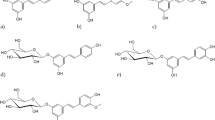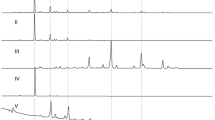Abstract
Pine cones, a renewable resource, are not used to their potential. Large quantities of cones are produced annually throughout the world, especially in pine plantations grown for the pulp and paper industry. They are collected, dried to facilitate seed release, and generally discarded. Some nurseries grind the cones into mulch or they may be sold for crafts, but consumer demand for cones is small compared to by-products from other industries. New uses for pine cones could provide additional income for forest landowners.
Access this chapter
Tax calculation will be finalised at checkout
Purchases are for personal use only
Preview
Unable to display preview. Download preview PDF.
Similar content being viewed by others
References
Fukuchi, K., Sakagami, H., Ikeda, M., Kawazoe, Y., Oh-Nara, T., Konno, K., Ichikawa, S., Hata, N., Kondo, H. and Nonoymama, M. (1989a). Inhibition of Herpes simplex virus infection by pine cone antitumor substances. Anticancer Res. 9, 313–318.
Fukuchi, K., Sakagami, H., Okuda, T., Hatano, T., Tanuma, S.I., Kitajima, K., Inoue, Y., Inoue, S., Ichikawa, S (1989b). Inhibition of Herpes simplex virus infection by tannins and related compounds. Antiviral Res. 11, 285–298.
Han, J.S. and Zinkel, D.F. (1990). Gas chromatography of resin acids with a methyl silicon fused-silica capillary column. Naval Stores Rev. 100, 11–15.
Han, J.S. and Zinket, D.F. (1991). Gas chromatography of resin acids with a BDS fused-silica capillary column. Naval Stores Rev. 101, 13–16.
Harada, H., Sakagami, H., Nagata, K., Oh-Hara, T., Ishihama, A., Hata, N.and Misawa, Y. (1991). Possible involvement of lignin structure in anti-influenza virus activity. Antiviral Res. 15, 41–50.
Hart, J.A. and Hillis, W.E. (1974). Inhibition of wood-rotting fungi by stilbenes and other polyphenols in Eucalyptus sideroxylon. Phytopathology, 64, 939–948.
Kossuth, S.V. and Biggs, R.H. (1981). Role of apophysis and outer scale tissue in pine cone opening. Forest Sci. 27, 828–836.
Kurakata, Y., Sakagami, H., Takeda, M., Konno, K., Kitajima, K., Ichikawa, S.,Hata, N., and Sato, T. (1989). Mitogenic activity of pine cone extracts against cultures splenocytes from normal and tumor-bearing animals. Anticancer Res. 9, 961–966.
Mattson, W.J. and Strauss, S.H. (1986). Are cone volatiles involved in cone finding by the red pine cone beetle, Conophthorus resinosae (Coleoptera: Scolytidae)? In: Proceedings of the 2nd Conference of the Cone and Seed Insects Working Party S2.07–01. pp. 185–204, September 3–5, 1986., Braincon, France.
Nagata, K., Sakagami, H., Harada, H., Nonoyama, M., Ishihama, A., Konno, K. (1990). Inhibition of influenza virus infection by pine cone antitumor substances. Antiviral Res. 13, 11–21.
Hara, T., Sakagami, H., Kawazoe, Y., Kaiya, T., Komatsu, N., Ohsawa, N., Fujimaki, M., Tanuma, S.I., and Konno, K. (1990) Antimicrobial spectrum of lignin-related pine cone extracts of Pinus parviflora Sieb. et Zucc. In Vivo 4, 7–12.
Petterson, R.C. (1984). The chemical composition of wood, In: The Chemistry of Solid Wood, R. Rowell (Ed.), pp. 57–126. American Chemical Society, Washington, D.C.
Petterson, R. C., and Schwandt, V. H. (1991). Wood sugar analysis by anion chromatography. J. Wood Chem. Technol. 11, 495–502.
Pullianen, E. (1972). Summer nutrition of crossbills (Loxia pvtvopsittacus, L. curvirostra, and L. leucoptera) in northeastern Lapland in 197. Annales Zoologici Fennici 9, 28–31.
Sakagami, H., Kawazoe, Y., Komatsu, N., Simpson, A., Nonoyama, M., Konno, K.,Yoshida, T., Kuroiwa, Y., and Tanuma, S.I. (1991). Antitumor, anitviral and immunopotentiating activities of pine cone extracts: potential medicinal efficacy of natural and synthetic lignin-related materials. Anticancer Res. 11, 881–888.
Sakagami., H., Oh-Hara, T., Kaiya, T., Kawazoe, Y., Nonoyama, M., Konno, K. (1989). Molecular species of the antitumor and antiviral fraction from pine cone extract. Anitcancer Res. 9, 1593–1598.
Schaffer, T.C. and Cowling, E.B. (1966). Natural resistance of wood to microbial deterioration. Ann. Rev. Phvtopathol. 4, 147–170.
TAPPI (1989). Official Test Method T-222 OM-88. Acid-insoluble lignin wood and pulp. Technical Association of Pulp and Paper Industry, Atlanta, GA. TAPPI Test Methods, Vol. 1.
Walter, J., Han, J.S., and Zinkel, D.F. (1989). Fate of resin acids in Kraft pulping. Naval Stores Rev. 99, 17–19.
Young, R.D. and Davis, J.L. (1990). Utilization of pine cones. Report submitted to the Grainger Foundation. 23 p.
Zinkel, D.F. 1983. Quantitative separation of ether-soluble acidic and neutral materials. J. Wood Chem. Technol. 3, 131–143.
Zinkel, D.F. and Rowe, J.W. (1964). A rapid method for the quantitative separation without alteration of ether-soluble acidic and neutral materials. Analytical Chem. 36, 1160–1161.
Zinkel, D.F. and Russell, J. (eds.) (1989). Naval Stores Production, Chemistry, and Utilization. New York, Pulp Chemicals Association. 1, 060 p.
Author information
Authors and Affiliations
Editor information
Editors and Affiliations
Rights and permissions
Copyright information
© 1994 Springer Science+Business Media New York
About this chapter
Cite this chapter
Micales, J.A., Han, J.S., Davis, J.L., Young, R.A. (1994). Chemical Composition and Fungitoxic Activities of Pine Cone Extractives. In: Llewellyn, G.C., Dashek, W.V., O’Rear, C.E. (eds) Mycotoxins, Wood Decay, Plant Stress, Biocorrosion, and General Biodeterioration. Biodeterioration Research, vol 4. Springer, Boston, MA. https://doi.org/10.1007/978-1-4757-9450-2_25
Download citation
DOI: https://doi.org/10.1007/978-1-4757-9450-2_25
Publisher Name: Springer, Boston, MA
Print ISBN: 978-1-4757-9452-6
Online ISBN: 978-1-4757-9450-2
eBook Packages: Springer Book Archive




